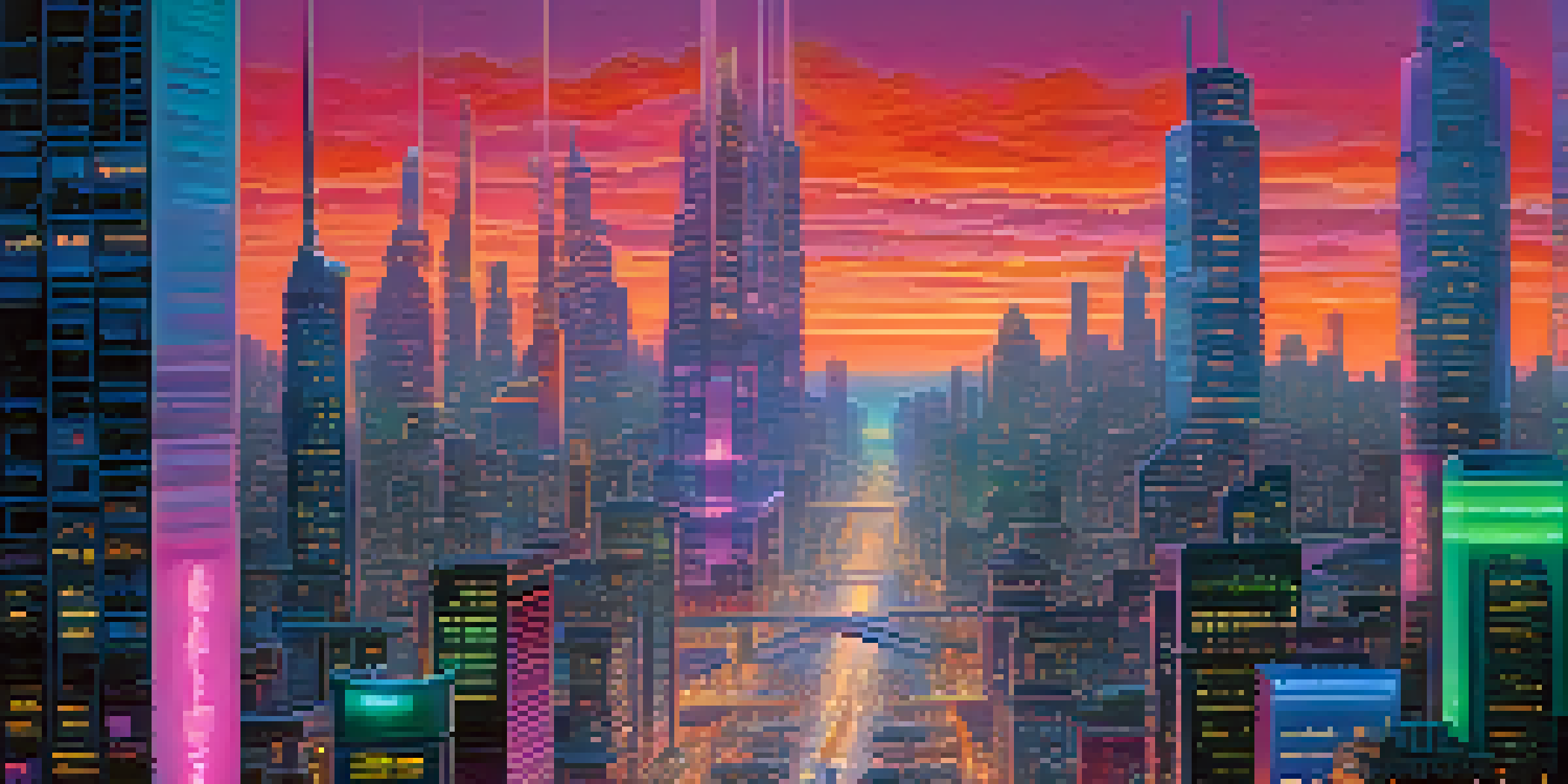Computer-Generated Imagery: The Future of Special Effects

What is Computer-Generated Imagery (CGI)?
Computer-Generated Imagery, commonly referred to as CGI, is the creation of still or animated visual content through computer software. It has revolutionized the way films, video games, and even advertisements are produced, allowing for the creation of visuals that were once thought to be impossible. Imagine a world where dinosaurs roam the earth again, or where superheroes fly through the sky—these stunning visuals are all made possible through CGI.
The magic of cinema is not in the technology, but in the ability to tell a story that resonates with the audience.
CGI can be seen in various forms, from simple 2D images to complex 3D animations that create lifelike representations of characters and environments. For example, the animation of characters in animated films like 'Toy Story' relies heavily on CGI to bring them to life. This technology not only enhances storytelling but also captivates audiences by immersing them in fantastical worlds.
As technology advances, the capabilities of CGI continue to expand, making it an essential tool in the entertainment industry. With each new development, filmmakers can push the boundaries of creativity, making experiences more engaging for viewers. Understanding CGI is crucial for anyone interested in the future of special effects.
The Evolution of CGI in Film and Television
CGI has come a long way since its inception. The journey began with simple animations in the early days, such as the iconic light cycles in 'Tron' (1982), showcasing the potential of digital effects. Fast forward to today, and we see CGI being used in blockbuster films like 'Avengers: Endgame,' where complex visual effects are seamlessly integrated into live-action scenes.

The advancements in CGI have not only increased the quality of visual effects but have also made them more accessible to filmmakers of all budgets. Independent filmmakers can now utilize CGI tools to create impressive visuals that compete with major studio productions. This democratization of technology has opened doors for creativity and innovation within the industry.
CGI Transforms Visual Storytelling
CGI allows filmmakers to create fantastical elements and complex narratives that immerse audiences in new worlds.
Moreover, the rise of streaming platforms has led to an increased demand for high-quality content, pushing CGI technology to new heights. As audiences expect more immersive experiences, filmmakers are challenged to create visual spectacles that captivate viewers, leading to a continuous cycle of improvement in CGI techniques.
The Role of CGI in Video Games
In the realm of video games, CGI plays a pivotal role in creating immersive environments and lifelike characters. The graphics in games such as 'The Last of Us' and 'Cyberpunk 2077' showcase the power of CGI to transport players into rich, interactive worlds. These graphics not only enhance gameplay but also evoke emotions, drawing players deeper into the narrative.
CGI is not just a tool; it's a canvas for creativity, allowing us to explore new worlds and experiences.
As technology advances, video game developers are leveraging CGI to create more realistic simulations. With the introduction of ray tracing, for example, light behaves in a way that mimics the real world, creating stunning visuals that make games feel more authentic. This level of detail enhances the player's experience, making them feel as though they are part of the game.
Additionally, CGI in video games allows for dynamic storytelling, where player choices can alter the outcome of the narrative. This interactivity, combined with breathtaking graphics, elevates video games to a form of art that rivals traditional cinematic experiences.
Innovations in CGI Technology
The landscape of CGI technology is constantly evolving, with innovations that enhance both the quality and efficiency of visual effects production. One notable advancement is the use of artificial intelligence (AI) in CGI, which streamlines processes such as animation and rendering. This not only saves time but also allows artists to focus on the creative aspects of their work.
Additionally, virtual reality (VR) and augmented reality (AR) technologies are becoming integral to CGI, creating new avenues for storytelling. Imagine watching a movie where you can interact with characters or explore environments in real time—this is the future that CGI is paving the way for. These technologies offer immersive experiences that were once limited to the realm of imagination.
Advancements in CGI Technology
Innovations like AI and VR are enhancing CGI production, leading to more realistic visuals and interactive storytelling.
As these innovations continue to develop, we can expect to see even more breathtaking visuals and engaging narratives. The combination of CGI with cutting-edge technologies will undoubtedly transform the way audiences experience entertainment.
The Impact of CGI on Visual Storytelling
CGI has transformed visual storytelling by allowing creators to depict stories in ways that were previously unimaginable. With CGI, filmmakers can visualize complex ideas and fantastical elements, making them accessible to audiences. For instance, in 'Avatar,' the lush landscapes and alien creatures were brought to life through groundbreaking CGI, immersing viewers in a new world.
Moreover, CGI enables filmmakers to showcase a broader range of emotions and actions. Characters can perform feats beyond human capability, such as flying or shape-shifting, which adds depth to their stories. This ability to stretch the limits of reality enhances the audience's connection to the narrative, engaging them on a deeper level.
As a result, CGI has become a vital component of modern storytelling. It not only enhances the visual aspect but also enriches the emotional experience, inviting viewers to explore new realms of imagination.
Challenges and Ethical Considerations in CGI
While CGI has opened up countless opportunities, it also presents challenges and ethical questions that need addressing. One major concern is the potential for over-reliance on CGI, which can detract from the artistry of traditional filmmaking. Striking a balance between practical effects and CGI is crucial to maintain the authenticity of a film.
Another ethical consideration involves the portrayal of characters and stories. As CGI technology becomes more advanced, the line between reality and virtual representation blurs. This raises questions about the implications of digitally recreating actors who have passed away, as seen in films like 'Rogue One: A Star Wars Story.' The industry must navigate these waters carefully to respect the legacy of individuals.
Ethical Challenges in CGI Usage
The rise of CGI raises important ethical questions about authenticity, character portrayal, and audience expectations.
Lastly, there's the issue of audience perception. With the rise of hyper-realistic CGI, audiences may come to expect increasingly elaborate visual effects, leading to a cycle of escalation. Filmmakers must ensure that the story remains the focal point, rather than allowing CGI to overshadow the narrative.
The Future of CGI in Entertainment
As we look to the future, the role of CGI in entertainment is set to grow even more significant. With advancements in technology, we can expect even more realistic visuals, deeper interactivity, and innovative storytelling techniques. Imagine a future where audiences can influence the outcome of a film by interacting with CGI characters in real time—this is the direction the industry is heading.
Furthermore, the integration of CGI with AI and machine learning will likely lead to more personalized content. Filmmakers may be able to tailor experiences based on audience preferences, creating unique narratives that resonate on a personal level. This fusion of technology and storytelling will redefine how we consume entertainment.

Ultimately, the future of CGI is bright, with endless possibilities for creativity and innovation. As technology continues to advance, the boundaries of storytelling will expand, offering audiences a chance to experience narratives in exciting new ways.